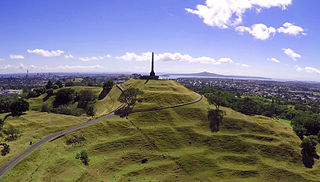
Taumako is the largest of the Duff Islands, in the Solomon Islands in the Pacific Ocean. This 5.7-kilometre-long (3.5-mile) island has steep sides and rises to a height of 400 metres above sea level. It is composed of basaltic lavas and pyroclastics like the other islands in the Duffs.

Sir Peter Henry Buck, also known as Te Rangi Hīroa or Te Rangihīroa, was a New Zealand doctor and a prominent anthropologist who served many roles through his life.
Obsidian hydration dating (OHD) is a geochemical method of determining age in either absolute or relative terms of an artifact made of obsidian.

Stephenson Percy Smith was a New Zealand ethnologist and surveyor. He founded The Polynesian Society.

Charles Franklin Wandesforde Higham is a British-born New Zealand archaeologist most noted for his work in Southeast Asia. Among his noted contributions to archaeology are his work about the Angkor civilization in Cambodia, and his current work in Northeast Thailand. He is an emeritus professor at the University of Otago in Dunedin.

Jisk'a Iru Muqu is a pre-Columbian archaeological site 54 kilometers (34 mi) south-east of Puno, Peru. The site lies in the mountains at elevation 4,115 meters (13,500 feet), in the Aymara community of Jachacachi, adjacent to the Ilave River drainage, of the Lake Titicaca Basin, Peru. Occupation of Jisk'a Iru Muqu spans from the Late Archaic to the Formative.

Kurī is the Māori name for the extinct Polynesian dog. It was introduced to New Zealand by the Polynesian ancestors of the Māori during their migration from East Polynesia in the 13th century AD. According to Māori tradition, the demigod Māui transformed his brother-in-law Irawaru into the first dog.

The township of Oturehua is in the Ida Valley of the Maniototo, in Central Otago, in the South Island of New Zealand.

Roger Curtis Green was an American-born, New Zealand-based archaeologist, professor emeritus at The University of Auckland, and member of the National Academy of Sciences and Royal Society of New Zealand. He was awarded the Hector and Marsden Medals and was an Officer of the New Zealand Order of Merit for his contributions to the study of Pacific culture history.

The Father Sebastian Englert Anthropological Museum is a museum in the town of Hanga Roa on Rapa Nui in Chilean Polynesia. Named for the Bavarian missionary, Fr. Sebastian Englert, OFM Cap., the museum was founded in 1973 and is dedicated to the conservation of the Rapa Nui cultural patrimony.

Archaeology of Samoa began with the first systematic survey of archaeological remains on Savai'i island by Jack Golson in 1957. Since then, surveys and studies in the rest of Samoa have uncovered major findings of settlements, stone and earth mounds including star mounds, Lapita pottery remains and pre-historic artifacts.
Janet Marjorie Davidson is a New Zealand archaeologist who has carried out extensive field work in the Pacific Islands throughout Polynesia, Micronesia and Melanesia.
Ioannis Liritzis is professor of physics in archaeology (archaeometry) and his field of specialization is the application of natural sciences to archaeology and cultural heritage. He studied physics at the University of Patras and continued at the University of Edinburgh, where he obtained his Ph.D. in 1980. Since then, he undertook postgraduate work at the University of Oxford, Université Bordeaux III, University of Edinburgh and the Academy of Athens.

Helen May Leach is a New Zealand academic specialising in food anthropology. She is currently a professor emerita at the University of Otago.
Hallie Ruth Buckley is a New Zealand bioarchaeologist and professor at the University of Otago.

New Zealand's archaeology started in the early 1800s and was largely conducted by amateurs with little regard for meticulous study. However, starting slowly in the 1870s detailed research answered questions about human culture, that have international relevance and wide public interest.

Tracey Tawhiao is a New Zealand Maori artist. Her ancestry can be traced to Ngai te Rangi, Whakatohea, Tuwharetoa.

The history of the Māori began with the arrival of Polynesian settlers in New Zealand, in a series of ocean migrations in canoes starting from the late 13th or early 14th centuries. Over several centuries of isolation, the Polynesian settlers formed a distinct culture that became known as the Māori.

Archeological Site 4-SK-4, in Tulelake, California, near Macdoel, California, is a stratified archeological site that was a hunter-gatherer village on the west shores of the Lower Klamath Lake. The site is located in the heart of the Klamath Basin wetlands, west of Indian Tom Lake. It has also been known as Nightfire Island and as Sheepy Island. Modern Modocs have called the island Shapasheni, meaning "where the sun and moon live", or "home of the sun and the moon.

Atholl John Anderson is a New Zealand archaeologist who has worked extensively in New Zealand and the Pacific. His work is notable for its syntheses of history, biology, ethnography and archaeological evidence. He made a major contribution to the evidence given by the iwi (tribe) Ngāi Tahu to the Waitangi Tribunal.




















